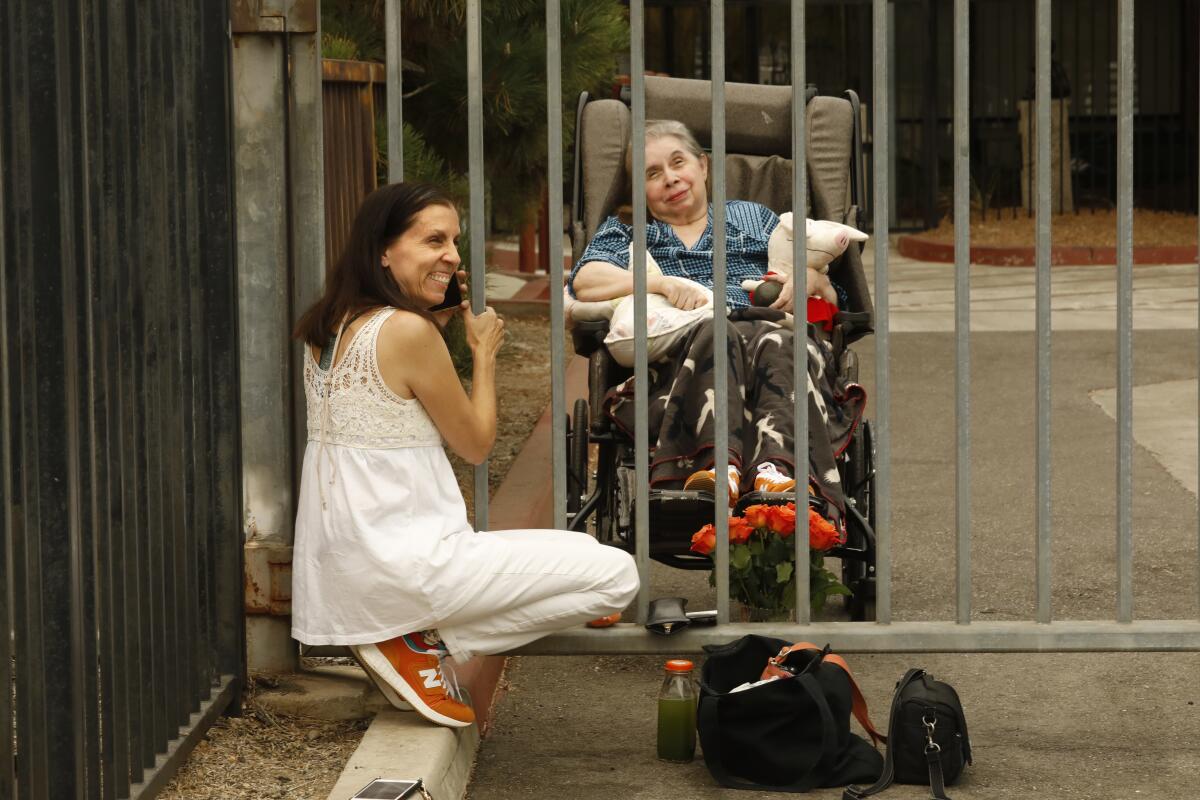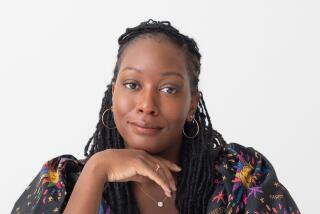Column: 35 years in a dungeon: The long-term effects of intimate partner violence we don’t talk about

- Share via
I spy Hannah Kozak on the sidewalk outside her mother’s nursing home in Reseda. She is a small, intense woman in orange suede New Balance shoes, holding a glass vase with brilliant orange roses.
Hannah approaches the closed metal gates of the facility, gray bars that keep residents in, strangers out. The gate is a sad symbol of family separation during the time of COVID. It’s been months since loved ones could visit, touch, hug or kiss.
For the record:
10:51 a.m. Sept. 20, 2020An earlier version of this story identified Hannah Kozak’s shoes as being Nikes. They are made by New Balance.
A few minutes later, two aides push her mother toward the gate. Rachel, 82, is sitting in a big padded wheelchair. A blanket covers her knees. Her right hand, gnarled and curled inward, is supported by a pillow. Tucked under her left arm is a stuffed toy, Olivia the pig.
“Mommy,” says Kozak, 60, through the bars, “can you explain who Olivia is?”
“Es todo,” replies her mother, who was born in Guatemala. She is everything.
Rachel’s shoes are peeking from under her blanket. They are the same orange ones her daughter is wearing.
Orange is Kozak’s favorite color, ever since her mother once showed up for parents night at her elementary school in a beautiful orange dress, and perfect makeup.
It’s one of Kozak’s few wonderful childhood memories of her mother. There have been so many years, so much pain since then. She hands the roses over the gate, along with a perfect avocado.
Rachel has a badly damaged brain. In 1974, her second husband, the man for whom she left her first husband, a Holocaust survivor, and five small children, hit her so hard she never recovered. According to a contemporaneous Northridge Hospital social service evaluation, the man had “an alcoholic history, many extramarital affairs, and has reportedly physically abused Rachel on many occasions.”
For the last 40 years, Rachel has been institutionalized.
It has taken decades for Kozak, who was 9 when her mother left her father, and 14 when her mother was irrevocably injured, not just to forgive her mother for leaving, but to forgive herself. She’d witnessed her stepfather repeatedly attacking her mother when she visited them on weekends.
“I was convinced it was my fault because I didn’t tell anybody,” said Kozak, a photographer and writer who chronicled her mother’s life and their journey of reconciliation in a new book, “He Threw the Last Punch Too Hard.”
::
I have written about domestic violence for decades, about how our justice system and attitudes have evolved, and about the devastating toll that partner violence takes on its victims and their families, especially the children. Few lives are untouched by its scourge; in 2018, a dear friend of mine was murdered by her husband.
For six years, Kozak said, she pulled out her hair, a well-documented response to anxiety and stress. At 22, she became a stuntwoman, mastering the art of flirting with death and mayhem. She learned to leap in front of moving cars, to fall off buildings, to hurtle down staircases. She did stunts for Cher, Lara Flynn Boyle and scores of others.
Her mother was brutalized in the 1970s, when domestic violence was not even recognized as a crime, and was usually considered a private matter between partners. Prosecutors often left it up to the victim to press charges. Rachel refused, Hannah said, and her husband, who died in March, was never charged.
It was not until 20 years later, in 1994, that President Clinton signed into law the Violence Against Women Act, which provided resources for victims and created an Office on Violence Against Women in the Justice Department. Democratic presidential nominee Joe Biden, a strong proponent of women’s rights, cosponsored the act. Studies showed that in the decade after the act’s passage, partner violence against women declined dramatically.
The Trump administration has proposed cutting funding for programs established by the act, and the office has watered down the definitions of “domestic violence” and “sexual assault,” which advocates see as a huge step backward.
::
For Hannah, her siblings and her mother, domestic violence is something they can’t ignore, not even for a minute.
After Rachel came out of the hospital, her ex-husband, Sol Kozak, took over her care.
A cagey investor who owned a dozen homes in the Valley, he was able to install her, with aides, in his rentals for six years. Eventually, though, she was moved to a nursing home in Tarzana, where she spent the next 35 years.
“It was a dungeon,” said Hannah, who would often become so depressed and guilty she could not bear to visit her mom. Her little sister, Esther, she said, was a stalwart, who would bring Rachel home on weekends until it became too hard.
In 2004, Hannah said, while working on a big-budget Korean film, she landed wrong and broke both feet.
That moment of crisis and vulnerability, she said, “gave me the epiphany I needed to heal with my mother.”
One of the most heartbreaking photos in the book, taken by Hannah in 2014, shows her mother being sprayed with water by an aide as she sits in her wheelchair in a tiled shower room. “This is the day I discovered that my mother was not being showered, but rather hosed, two times a week,” she writes. “… I felt as if my mother was still being abused.”
Shortly after that — and many years of anguished advocating by Hannah and her family — Rachel moved to the Los Angeles Jewish Home in Reseda, where Hannah visits as often as she can.
Before COVID, they would sit in the garden, listening to music or watching kittens frolic. Now, they can only see each other through the gray bars.
“Mommy,” says Hannah, “do you want to listen to some music?”
“Yeah!” says Rachel, whose communication is minimal.
Hannah plays “Hoy Tengo Ganas de Ti,” a sultry duet by Christina Aguilera and Alejandro Fernandez.
As they sing, Rachel is smiling. She has a dreamy look on her face.
“Mommy, I’ll see you on Tuesday,” says Hannah.
Holding her avocado like a precious gift, Rachel is wheeled back inside by the aides.
Hannah, with tears running down her cheeks, waves and waves until her mother is gone.
More to Read
A cure for the common opinion
Get thought-provoking perspectives with our weekly newsletter.
You may occasionally receive promotional content from the Los Angeles Times.











